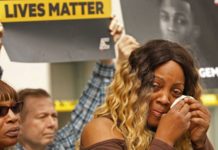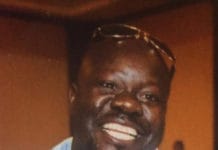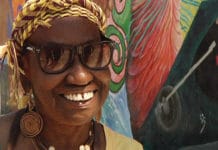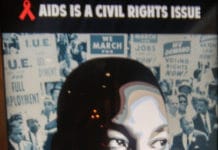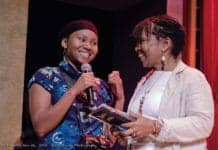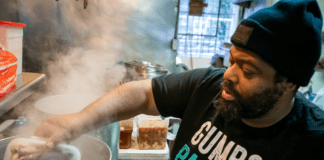by Wanda Sabir
This week has been a sojourn through important San Francisco Bay Area history. I will never look at Sutro Tower, that lone antenna on the highest peak in San Francisco, the same again after reading in Belva Davis’ memoir, “Never in My Wildest Dreams: A Black Woman’s Life in Journalism,” how Davis and photographer Dave Ambriz in 1973 rode up to the top on a makeshift lift, as the wind blew and she steeled herself for the shot for the news story assignment (Davis, Page 132).

But this type of assignment produced really edgy coverage on the noontime show she anchored. It also allowed Davis the leverage later on to produce some of her more coveted award-winning features on issues previously not covered by the press, an exclusive club for white men, she and others slowly changed.
If one looks at her series on breast cancer, AIDS, the Black Panther Party, COINTELPRO (before the investigations into illegal FBI and police surveillance), Three-Strikes Law in California, one sees how despite her job to present the news clearly and comprehensively, Davis began to pitch and get assignments which spoke to her personally, a child born in Monroe, Louisiana, in the Depression to a 15-year-old laundress, self-educated entrepreneurial dad. Davis, raised in West Oakland initially in the basement of a Victorian mansion on dirt floors.
I see why Bill Cosby called the names of freedom fighters like Harriet Tubman when he spoke of Davis’ legacy at her tribute at Yerba Buena Center for the Arts Feb. 23. When one reads of how far she has come, the journey sounds like she could have known Tubman (smile). Dirt floors in an urban enclave in the 1940s – West Oakland then – a place where Black people were just 2 percent in a population of immigrants from Greece, Portugal, Ireland, Germany and Italy. The affluent lived in the hills, the poor folks in the flatlands.
Her father and the men in Davis’ family migrated west to avoid being lynched when her uncle, who had been injured at the Armour Meat Packing Co., sued the company located in Monroe, Louisiana, and won. Davis writes of the journey west with her younger brother on a train so full she sat on her suitcase for the journey as she watched wide-eyed the Black enlisted men in uniform.
If one looks at her series on breast cancer, AIDS, the Black Panther Party, COINTELPRO (before the investigations into illegal FBI and police surveillance), Three-Strikes Law in California, one sees how despite her job to present the news clearly and comprehensively, Davis began to pitch and get assignments which spoke to her personally.
Davis speaks of lynch mobs in the South and North often in her memoir and major KKK rallies at the Oakland Auditorium just 15 years before she arrived in Oakland. The Ku Klux Klan was nationwide with dire unrestrained, unlawful yet unchecked consequences for Black citizens – a situation that followed her north.
It was this kind of personal injustice that fueled Davis’ work once she’d earned her chops. She started a Black beauty contest, Miss Bronze America, when Miss America refused to allow Black women entrance prior to 1970 (74-82). She writes about protests here in San Francisco, an indication that the goals of the Civil Rights Movement spread across the nation.
In her amazing book, Davis writes of how as the first person in her family to graduate from high school, she couldn’t afford college, despite a scholarship, so she got married and started working at the Oakland Navy Supply Center as a clerk typist. Two children later, she left the abusive marriage and began her journalism career, which was never lucrative, easy or without sacrifice. Yet to look at Ms. Davis Saturday evening, Feb. 23, as much of Northern California celebrated Chinese New Year with the annual parade, there she was, hair styled just so, in a lovely two piece suit, matching shoes, surrounded by colleagues and friends who appreciated her tenacity and daring attitude which kept her saying yes, even when she did not know what exactly that yes entailed or how she was going to pull it off – but with research, support and mentors along the way, she always did – one would never believe the toll such tenacity took on her family and herself.

My friend and colleague from the College of Alameda, Carlotta Campbell, was with me at the Davis tribute and knew everyone, so it was nice listening to her stories and watching the happiness with which she was greeted by one journalist after another. It was certainly a reunion of sorts for a lot of people who no longer live in the area. People flew out for the tribute from Los Angeles, Chicago and elsewhere. Bill Cosby, a great friend of Ms. Davis, appeared in two videos. In one, he kept confusing Ms. Davis with Harriet Tubman, who worked as a general in the Union Army, and according to Cosby, “knew George Washington Carver and Booker T. Washington.”
Humorous, yet the analogy certainly rang true as over the course of a splendid program led by Charles Ward and supported by a marvelous honorary committee headed by the Bay Area Black Journalists Association, which Davis helped found, AFTRA, which she led for many years, KQED and others, truly if there were a modern symbol for Gen. Tubman, Davis is certainly it.
Sen. Diane Feinstein gave a special tribute to Ms. Davis and read a letter from President Obama, thanking her for her tireless work in truly being the voice of the silenced and voiceless for the past 50 years. Funny how Davis’ career parallels that of her marriage to Bill Moore. The couple celebrated their 50th wedding anniversary that evening and so did we all as Lamont McLemore, founding member of The 5th Dimension, held his glass in the air, as did we all, and wished the couple well.
Sen. Diane Feinstein gave a special tribute to Ms. Davis and read a letter from President Obama, thanking her for her tireless work in truly being the voice of the silenced and voiceless for the past 50 years.
There were lots of flowers given to Davis while she could smell them, a spa day too, with a brunch invite for Bill to join Belva later on that afternoon (smile).
The couple’s 50-year marriage is in itself a tribute to their teamwork and synergy, witnessed in mutual appreciation for each other. The two certainly, as Davis tells it, played to each other’s strengths. There were no prescribed gender roles in their household, and so from this team both on and off the air grew journalists who brought news to a public from a perspective perhaps not couched in the dominant discourse of the times.
If nothing else, Ms. Davis is current. I am surprised no university has awarded her an honorary doctorate degree in all these years, considering how this self-made woman has continued to inspire and mentor journalists from many of the more prestigious institutions, UC Berkeley’s School of Journalism and San Francisco State University’s two of its finest. SFSU will house her papers and effects. Funds raised that evening will go to support the Belva Davis Archive Project at SF State. The University Library also plans to house Bill Moore’s photographs as well. Support can be mailed to: Belva Davis, 588 Sutter St. #297, San Francisco, CA 94102.

She writes: “I must confess that I didn’t grow up with an inherent affection for unions. In my family, we knew that union shops were the gatekeepers and that they looked out for their existing white members at the expense of minority newcomers. Unions made getting work harder for the men in my family – my father, uncles and even my husband. They couldn’t get a high-paying union job without union membership, and they couldn’t obtain union membership unless a certain number of white members were willing to withstand rebuke from their fellow journeymen and vouch for the newcomers” (181).
Earlier in “Never in My Wildest Dreams,” Davis tells us how she prodded her white journalist colleagues to vouch for her husband so he could join the union and get a full time job, which he did as the first Black man to work as a cameraman at a major TV station, KTVU. The woman shooting the tribute, Cordetta Spells, was, in 1985, the first Black woman camera person to work for a major network station in the country when she went to work at KPIX-TV. The evening was filled with such mavericks and, as Davis tells it and Spells echoes years later, it was not easy being the first.
It was dicey for the family of four to make ends meet. At one time Davis says she was bringing home about $80 and her husband not much more, but they were able to meet their $132 monthly mortgage on their El Cerrito home. Journalism was not a lucrative career and Davis writes of juggling multiple gigs at different outlets so she could meet financial obligations.
Just as many Black singers credit their start to the Black church, Davis’ journalism career too began in the Black community, first at the Independent and Jet, the Sun-Reporter, later KDIA, where she launched The Belva Davis Show.
She writes: “For years I had gotten along by gluing together the chips and pieces of part-time and freelance paychecks into a mosaic that did not quite yet depict a career” (62). This until one of Davis’ friends, Odessa Broussard, traffic manager at KDIA, asked her if she would consider taking her place at the station. Broussard was married and expecting the first child of Allen Broussard, the eventual first African American president of the California Judges Association and associate justice of the California Supreme Court.
Just as many Black singers credit their start to the Black church, Davis’ journalism career too began in the Black community, first at the Independent and Jet, the Sun-Reporter, later KDIA, where she launched The Belva Davis Show.
And so The Belva Davis Show was launched, two hours on Saturdays. Davis secured advertising for her show and the station bureaucracy left her to her “womanly devices.” Her first guest was Ella Fitzgerald, and the list of established and up and coming artists – many performing in clubs in both Oakland and San Francisco – includes Diahann Carroll and Nancy Wilson, who appeared in her studio, where she had a live listening audience of 100 and a grand piano. How cool is that?! When the artists could not make a live appearance, Davis recorded interviews at clubs where she had to “haul her chunky tape recorder where she spoke to artists before or between sets” (65).
These interviews were not always successful, as illustrated in Davis’ attempt to interview Miles Davis, who refused; however, she alone was the choice when, as the lone woman, Black woman at that, persuaded Frank Sinatra appearing at the Cow Palace in San Francisco to allow her an interview (65).

“‘I’m sorry, Mr. Sinatra … It’s just that I’m terribly nervous. I know I shouldn’t be nervous, it’s just that …’
“He raised a hand. ‘Stop. Let me tell you something.’ He leaned forward and stared intently at me. ‘The day I walk out on stage and I’m not nervous is the day I quit’” (66).
It is here that we meet Bill Moore, Davis’ “silent partner,” an old friend who’d worked in Chuck Willis’ darkroom and would deliver Davis’ copy when she was running late. She didn’t realize she loved Bill until her friend Nancy Wilson told her she “should marry him and stop running around with these musicians,” a sentiment echoed by her son, who asked Bill one day when “he was going to marry his mother” (67-68). This chapter, entitled, “Lucky 13,” is lucky for many reasons – the most important: love.
In her friend and husband Bill Moore, Davis had the support to really fly. Bill neither tethered or clipped her wings; rather here and elsewhere in “Never in My Wildest Dreams,” we see how the two model unconditional love. Bill is a man who is very secure in himself and his manhood and has no problem supporting his ambitious wife. One could see this when the two were on stage at the end of a wonderful evening, then later on as well-wishers mingled, took photos with the star couple, said hi to acquaintances – some who hadn’t seen each other in many years.
One of the first visible power couples – Bill and Belva – at one point the two were the only parents their children knew who had their own his and hers set of gas masks, part of the survival gear for coverage of the anti-Vietnam War protests in Berkeley, the Free Speech Movement and the San Francisco State Student Strikes. While Belva Davis was not necessarily the flavor of the month, Moore definitely had a lot more trouble getting refrigerated as both Black and male, so the two played to their strengths; and where Bill was denied entree, his wife wasn’t and so the couple was able to further righteous causes that benefited their people and ultimately other underrepresented citizens and so this nation.
W.E.B. Dubois, Malcolm X, Muhammad Ali (then Cassius Clay) … Fidel Castro. With her coverage of the embassy bombings in Kenya and Tanzania, American networks’ under-reporting of what happened there, especially to African people, was not applicable to her station, as she challenged the news copy writer not to let it happen again, in a climate where then and now fatalities of the non-Americans are not counted.
One of the first visible power couples – Bill and Belva – at one point the two were the only parents their children knew who had their own his and hers set of gas masks, part of the survival gear for coverage of the anti-Vietnam War protests in Berkeley, the Free Speech Movement and the San Francisco State Student Strikes.
She writes of Martin King’s visit to the Santa Rita prison to check on Joan Baez, a friend and civil rights activist of his who was jailed for her protests. Davis reflects on the wait and how, in the end, her one carefully crafted question and King’s answer was the one the major stations picked up and carried long after the cold drizzly day, Jan. 14, 1968, was past and King was shot and killed just four months later (105).
She writes often of her hair and the effects of weather on it as it reverted back to its natural state. At Santa Rita, the camera man commented, “Belva, what’s happening to your hair,” as without umbrella or scarf, it behaved naturally (smile). She gave him a look that silenced him.
At the tribute, as luminaries shared their stories of Ms. Davis, with Barbara Rogers, host of Comcast Newsmakers, and Pam Moore, news anchor at KRON-TV, giving opening remarks, followed by Attorney General Kamala Harris, Sen. Dianne Feinstein, Congresswoman Barbara Lee, John Boland, president of KQED, and Bob Butler, vice president of the National Association of Black Journalists, announcing each speaker (smile), and singers Crystal Jackson and Nicholas Bearde with a dynamite quartet headed by Lloyd Gregory (guitar), Ron Belcher (bass), Deszon Claiborne (drums) and Glen Pearson (piano) providing great entertainment, the evening, to put it lightly, was delightful.
However, my favorite part of the evening – besides an opportunity to see Davis’ children, whom I’d read so much about, Steven and Darolyn Davis, share stories about their mother – was the panels, moderated by former San Francisco Mayor Willie Brown, a special treat I will never forget.

Kim Roberts Hedgpeth, former national executive director of AFTRA, shared wonderful accounts of Davis’ organizing skills around union representation in all aspects of broadcast journalism. This also extended to programs advertised on such news shows. Where was the diversity in the commercials, TV sitcoms, talk shows? She challenged studios to let their dollars work in favor of more equitable programming all around, especially in giving work to actors of color.
Other panelists with Marinucci and Roberts Hedgpeth were Mary G.F. Bitterman, president of The Bernard Osher Foundation, Stacy Owen, assistant news director at KNBC TV Los Angeles, and Dan Rosenheim, vice president and news director of KPIX/KBCW TV.
The preceding panel featured Phil Bronstein, executive chairman of the Center for Investigative Reporting, Danny Glover, actor and activist, Ron Magers, news anchor at ABC 7 TV in Chicago, Roxanne Russell, associate professor of journalism at George Washington University, Fred Zehnder, retired news director for KTVU TV and publisher of two East Bay newspapers.
I’d read about Professor Russell in Davis’ book, so to see the woman described as fresh out of college, full of theory with no practical experience was a treat. Gone was the miniskirt and long blonde hair; however, the woman Davis had initial trepidation working with so many decades later retold some of these stories of the two of them against a male-centered, white male-centered view of the world which slowly, with special programming and coverage in their newsroom, began to change.
Davis and Russell turned the KPIX-TV newsroom out with coverage of stories previously not considered newsworthy, like breast cancer, the prison system and other issues which always seemed to garner a local Emmy (smile). Davis knew these people because she was one of them. Never forgetting her Monroe, Louisiana, or West Oakland roots, the struggles of her mother and father, uncle and husband for that matter, Davis championed the silent majority who were her audience, her litmus test.
Belva Davis’ life exemplifies that of a woman who was inspired and rightly guided by the early principles she shares with her readers: being useful, having faith and patience, and believing in oneself and one’s capacity for greatness.
Ron Magers spoke of how he used Davis as his ethical compass and had to break a contract with a station – scary stuff – but his tenacity and belief in his convictions won out.
When one thinks about “trust walks,” Belva Davis’ life exemplifies that of a woman who was inspired and rightly guided by the early principles she shares with her readers: being useful, having faith and patience, and believing in oneself and one’s capacity for greatness. Adept from childhood at being invisible and when visible learning to keep her own consul, Davis’ “Never in My Wildest Dreams” is just that 50 years later, a dream come true.
Listen to Wanda’s prerecorded interview with Belva on Wanda’s Picks Radio. It follows the live one with Jerri Lange, at http://www.blogtalkradio.com/wandas-picks/2013/02/22/wandas-picks-radio-show.
Bay View Arts Editor Wanda Sabir can be reached at wsab1@aol.com. Visit her website at www.wandaspicks.com throughout the month for updates to Wanda’s Picks, her blog, photos and Wanda’s Picks Radio. Her shows are streamed live Wednesdays at 6-7 a.m. and Fridays at 8-10 a.m., can be heard by phone at (347) 237-4610 and are archived on the Afrikan Sistahs’ Media Network.

 Store
Store



